|
"Among the
stone specimens (in the Smithsonian collection)
there is a very wide range in size, the largest weighing upward of 30
pounds and the smallest scarcely an ounce."--------1912,
Frederick Webb Hodge, "Handbook Of American Indians North Of Mexico,
vol. I," Smithsonian publication, p. 121.
"The term "celt" is used to refer to an
ungrooved, tapered, ground stone axe with a centered edge at one end. An
average size is roughly between 3 to 6 inches (8 to 16 cm) in length---."---------1999,
Errett Callahan, "Celts And Axes, Celts In The Pamunkey And Cahokia
House Building Projects," Primitive Technology A Book Of Earth
Skills, p. 95.
"The
indisputable fact that vast areas of Europe, North America, and Asia
were forest-covered when the first agriculturists penetrated, meant that
some procedures had to be immediately introduced to clear the land for
cultivation."------1973,
John Coles, "Archaeology By Experiment" p. 19.
"The clearance of
forest may be said to represent the first major impact of man upon his
environment, as it was the first step leading to a landscape controlled
to a great extent by man."--------1973,
John Coles, "Archaeology By Experiment" p. 19.
"Axes
with two or more grooves are rare excepting in the Pueblo country, where
multiple grooves are common."----1912,
Frederick Webb Hodge, "Handbook Of American Indians North Of Mexico,
vol. I," Smithsonian publication, p. 121.
"Field
researches have produced a great quantity of stone chopping implements
from Neolithic settlements, and certain areas of the Soviet Union have
proved exceptionally rich. In the standard archaeological publications
these tools are divided into axes, adzes, and chisels."---------1970,
S. A. Semenov, "Prehistoric Technology, An Experimental Study Of
The Oldest Tools And Artifacts From And Artifacts From Traces Of
Manufacture And Wear," p. 126.
"Australian
stone hatchets usually had a dolerite, diorite or basalt head with a
ground edge, bound with an adhesive into a wrap-around split-wood
handle.----they were an indispensable tool, widely used to extract honey
or possums from tree hollows, cut footholds, in tree trunks, remove bark
for shelters or canoes or cut and dress blanks for wooden implements"---------2013,
Mike Smith, "The Archaeology Of Australia's Deserts," p. 288.
"Interestingly,
however, of the 600,000 stone artifacts recovered (at
the Neolithic sites at Sanakallu-Kupgal in southern India)
during recent investigations, the vast majority (80 to 90 percent)
comprised dolerite debitage from the manufacture of bifacial edge-ground
axes"--------2007,
Adam Brumm, Nicole Boivin, Ravi Korisettar, Jinu Koshy, and Paula
Whittaker, "Stone Axe Technology In Neolithic South India: New
Evidence From The Sanganakallu-Kupgal Region, Mideastern Karnataka,"
Asian Perspectives, Vol. 46, No. 1 Spring, p. 66.
"In southern
Scandinavia, the recovery of tens of thousands of flint axes makes them
one of the most common tool types from the Neolithic (4,000-2,000 B.C.)"--------2011,
Lars Larsson, "The Ritual Use Of Axes," Stone Axe Studies
III, p. 203.

LATE STONE AGE AXES & CELTS
STYLE VARIATION
WORLDWIDE
est. 35,000 YEARS AGO TO PRESENT DAY
Grooved and ungrooved stone axe heads, that were designed to be
used on handles, have been reported from practically everywhere in the
world. From North America to India and most land masses in between.
Their use increased with the development of agrarian societies, mainly
to clear land. |
|

CLICK ON PICTURE FOR LARGER IMAGE
AXES AND CELTS
AFRICA, EUROPE, AMERICAS & NEW
GUINEA
This picture shows a group of axes
and celts from different areas in the world. There is a wide variety of styles
and sizes. Some are very simple while others are so finely crafted
they were obviously used as display and ritual items. The axes that
fall in between these two parameters, worldwide, were made in every conceivable shape.
Axe styles range from flat
to almost round or even square in cross-section. Their outside edge
(silhouette) can be, rectangular, triangular, oval, teardrop, or
even T-shaped. Like projectile point types, there is a great variety
of main and sub-type styles of axes. The axe with the handle, to the
right in the picture, was collected in New Guinea. The very large
celt at the left, was reportedly found in one of the Sahara desert
region countries of either Mali or Niger. Other axes in this picture
were found on sites in Arizona, Guatemala, Denmark, and Panama. |
|
|
Stone Age cultures around the world have left behind an
amazing assortment of different types of stone axes. Some are very
simple, little more than a sharpened pebble. While others are so finely
crafted they were obviously used as display and ritual items. But the
huge numbers of axes that fall between these two parameters represent every conceivable shape
and style. Some of the most impressive are the raised
ridge axes from the eastern U.S. But worldwide, axe styles range from
flat to almost round or even square in cross-section. Their outside edge
(silhouette) can be, rectangular, triangular, oval, teardrop, or even
T-shaped. Like projectile point types, there is a great variety of main and sub-type styles of axes. |
|

CLICK ON PICTURE FOR LARGER IMAGE
AXE & CELTS
MADE BY PECKING AND FLAKING
UNITED STATES, GUATEMALA, &
DENMARK
These four axes and celts
illustrate different styles of manufacturing techniques. The hard
stones, such as granite, are shaped by pecking the surface with a
hammerstone (axe at left & third). More brittle stones, such as chert, are shaped by flaking
with either a hard (stone) or soft (antler or wood) hammer (second
from left & fourth). Then the
surfaces are often smoothed to varying degrees. |
|
|
The oldest axe with a ground (as
opposed to flaked) cutting edge is
reported from a cave site in northern Australia and dates to 35,500
years ago. The earliest European axes begin to appear sometime between 20,000 and
30,000 years ago. In North America, estimated dates for the earliest and
latest use of stone axes range between 5,500 to 500 years ago. The most recent use of
stone axes can be found in New Guinea, where they were still in use in
the 1960's. |
|
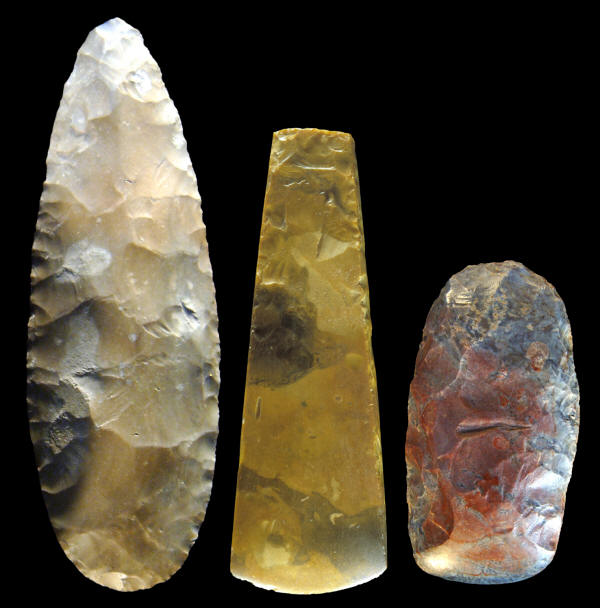
CELTS
MADE BY PERCUSSION FLAKING
GUATEMALA, DENMARK & AFRICA
These three celts
illustrate different forms of wood cutting blades that may once have
been mounted onto handles and served as axes. They were all made from
flake-able materials, as opposed to hard stone. The Maya culture celt on
the left is a percussion flaked biface that was edge trimmed by pressure
flaking and has no surface grinding. It's made of Colha chert and
measures 8 1/2 inches (21.5 cm) long. The Neolithic celt in the center
was made with both direct pressure flaking and indirect punch-flaking.
Grinding removed the majority of the flake scars. This celt is made of
Danish flint and measures 5 7/16 inches (14.9 cm) long. The celt on the
right was made by percussion flaking and surface grinding and polishing.
It was found in the Sahara desert region of Mali or Niger. This celt is
made from a good quality chert and it measures 5 inches (12.6 cm) long. |
|
|
Experiments have shown that stone axes are very
efficient tree clearing tools. In 1954, a tree cutting experiment in Denmark, with
polished flint axes, showed that one man could clear 2 hectare (4.94
acres) in a week. Trees larger than 35 cm (13.75 inches) were not felled
but were girdled and left to die. Another report of a tree cutting
experiment in Czechoslovakia in 1970 showed that a 14 to 15 cm (5 1/2 to
5 7/8 inches) tree could be cut down in 7 minutes with a polished flint
axe. An axe cutting experiment near Leningrad in 1951 showed that a fir
tree 25 cm (9 7/8 inches) in diameter could be cut through in 20 minutes
without the person doing the cutting having any previous practice. |
|
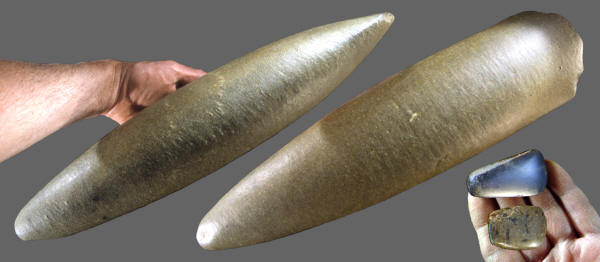
CLICK ON PICTURE FOR LARGER IMAGE
VERY LARGE CELT
AFRICA
This very large celt was
reportedly found in one of the Sahara desert region countries of either
Mali or Niger. The small celts at lower right illustrate a size
comparison. Stone axes and celts vary greatly in size, depending on
their intended use. Large heavy axes could have been used for such tasks
as breaking ice, pounding stakes, or splitting logs. The size variation
is quite remarkable. Hodge reported in 1912, that the axes in the
collection of the Smithsonian Institution range in size from "upwards of
30 pounds to scarcely an ounce." An average size for a stone axe seems
to be between 3 and 6 inches (8 cm to 16 cm) in length. |
|
|
Stone axes were hafted onto wooden handles with the
blades secured in a position that is parallel with the handle. Adzes
were hafted in a position that is perpendicular to the handle. Axes were
attached to handles in several different ways. One technique used
adhesives made from animal, vegetal or mineral ingredients. Another
technique simply holds the axe in place with friction when the axe is
wedged tight enough into the handle. Various types of natural fibers and
other materials were also used to tightly wedge an axe in place. Some
axes were also attached to a handle
with the use of strips of animal hide or sinew. Australian axes were
hafted with an adhesive and a wrap-around split-wood handle. |
|
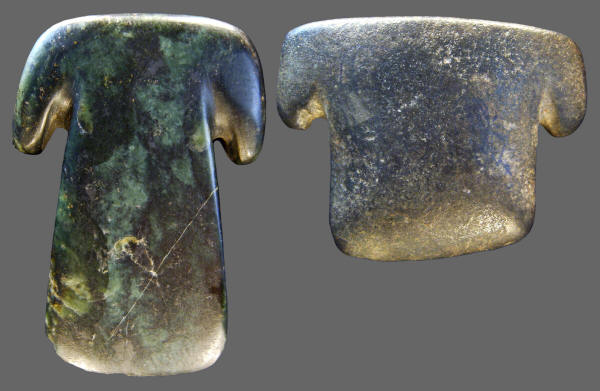
T-SHAPED AXES
SOUTH AMERICA
Both of these axes were
made from hard stone and manufactured by pecking and grinding. They
represent one of the more unique shapes of stone axes, in the form of a
T. The South American countries of Ecuador and Peru are two of the more
likely areas where they were found. The greenstone axe on the left
measures 3 1/2 inches (9 cm) long. |
|
|
Stone axes vary greatly in size, depending on their
intended use. Large heavy axes could have been used
for such tasks as breaking ice, pounding stakes, or splitting logs. The
size variation is quite remarkable. Hodge reported in 1912, that the
axes in the collection of the Smithsonian Institution range in size from
"upwards of 30 pounds to scarcely an ounce." An average size for a stone
axe seems to be between 3 and 6 inches (8 cm to 16 cm) in length. |
|
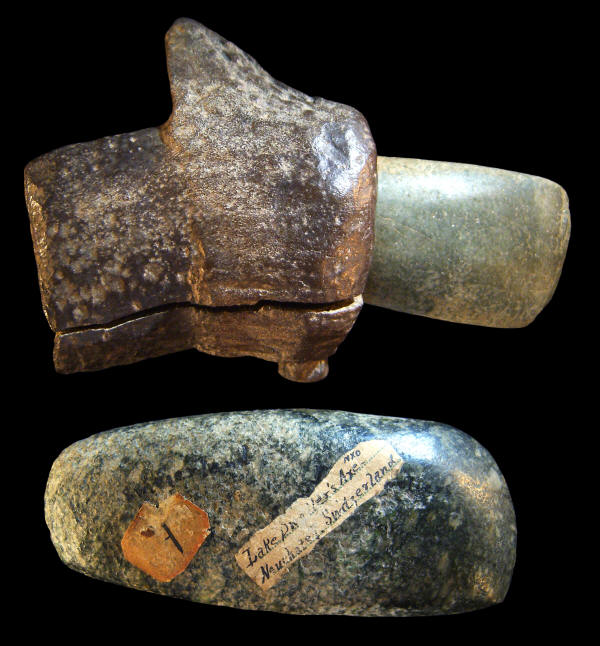
CLICK ON PICTURE FOR LARGER IMAGE
CELTS
(UNGROOVED AXES)
SWITZERLAND
NEOLITHIC
Both of these
celts were found on Neolithic Swiss Lake sites in Switzerland.
The celt at top was found on one of the Neolithic sites along Lake Cortaillod and the lower example was found on a site at Lake Neuchatel,
Switzerland. Antler socketed celts, like the example at the top of this
picture, are one of the most famous tool types found on Swiss lake dwelling
sites. The antler sockets serve as shock absorbers to protect the handle
from splitting. The lower celt measures 5 inches (12.7 cm) long. |
|
|
Axes that were shaped by hammerstone pecking were generally
made from hard dense stones such as granite, greenstone or hematite. But
when the best stone was not available, softer stones were also used,
such as sandstone. Axes that were made by direct or indirect percussion
flaking were made from more brittle stones like chert. |
|
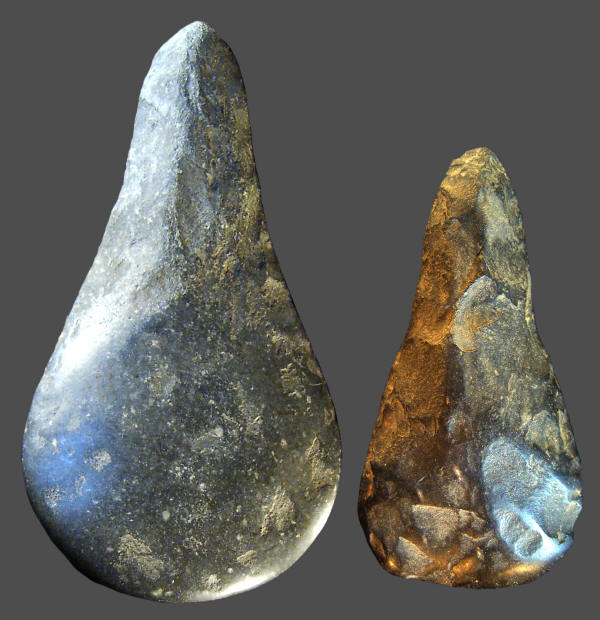
STEMMED CELTS
PANAMA
This style of wood chopping tool has been referred to as a stemmed
or wasted axe, but more correctly as polished celts. They are unique
for their pointed hafting element and wide blades. This is a styles
of celt that can be found in Panama. These examples are made of
either tufa or basalt. The largest example measures 8 9/16 inches
(21.8 cm) long. |
|
|
There are three basic manufacturing techniques for making
axes. They were shaped by either hammerstone pecking, percussion flaking
or by grinding a cutting edge on a naturally pre-shaped pebble. The
surfaces were reduced to various degrees of smoothness by grinding. Most
grooved and ungrooved axes in North America were made from hard stone
that was shaped by hammerstone pecking and smoothed with an abrading
stone and fine grit. In northern Europe, large numbers of axes were made
from chert or flint and shaped by both direct flaking and indirect punch flaking. Surface
smoothing from grinding ranges from little to none, to many examples that are completely ground smooth
over their entire surface. |
|
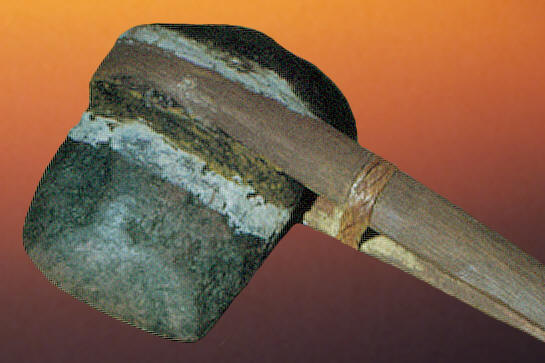
PHOTO CREDIT, PETE BOSTROM &
LITHIC CASTING LAB'S COLLECTION OF ORIGINAL IMAGES
COMPUTER ALTERED IMAGE
HAFTED GROOVED AXE
AUSTRALIA
This
picture illustrates an Australian axe that is hafted with an
adhesive and a wrap-around split-wood handle.
The oldest axe with a ground (as
opposed to flaked) cutting edge is
reported from a cave site in northern Australia and dates to 35,500
years ago. |
|
|
Axes represent one
of the most important and one of the largest utilitarian tool types ever
invented by late Stone Age cultures around the world. In most areas, where there were trees, the
archaeological record shows that people began using axes sometime after
35,000 years ago. One exception would be in some areas of the Pacific
where adzes were used as the main wood cutting tool to cut down trees.
Another exception would be in North America where Early Archaic Dalton
people were also using adzes to cut their trees. |
|
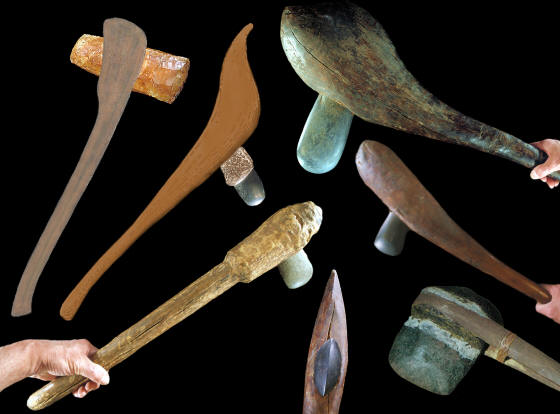
CLICK ON PICTURE FOR LARGER IMAGE
HAFTED AXES
WORLDWIDE
Stone axes were hafted onto wooden handles with the
blades secured in a position that is parallel with the handle. Adzes
were hafted in a position that is perpendicular to the handle. Axes were
attached to handles in several different ways. One technique used
adhesives made from animal, vegetal or mineral ingredients. Another
technique simply holds the axe in place with friction when the axe is
wedged tight enough into the handle. Various types of natural fibers and
other materials were also used to tightly wedge an axe in place. Some
axes were also attached to a handle
with the use of strips of animal hide or sinew. Australian axes were
hafted with an adhesive and a wrap-around split-wood handle.
The axe at top right and just below it are from New Guinea and was
used mainly to split logs. The larger axe is known as a bulbous axe. The
axe at lower right is from Australian and is hafted with an adhesive and
a wrap-around split-wood handle. The axe at lower left
is reported to have been found many years ago in a dry rock shelter in
New Mexico. The celt was added to the handle after it was found. The axe
at top left shows the hafting technique for a Neolithic period flint axe
from northern Europe, the handle is computer generated. The axe at left
center is a computer generated image that shows the hafting technique
for a hard stone polished celt or axe that was found on a Swiss Lake
Dweller site in Switzerland. |
|
|
The greatest number of stone axes begin to appear in the
archaeological record when people need them for chopping down trees.
They are a technological advancement that arises from societal pressures
to produce more food. Forest clearing is one of the first major impacts
that humans have on the environment. The process begins as
hunter-gatherers evolve into agrarian societies and begin clearing land
for cultivation and grazing. Axes appear
in history just when they are needed.
Which brings to mind that old saying, "invention is the mother of
necessity." |
|
"REFERENCES"
1888, Holmes, William H., "Ancient
Art Of The Province Of Chiriqui," Sixth Annual Report Of The Bureau
Of Ethnology To The Secretary Of The Smithsonian Institution.
1912, Hodge, Frederick Webb "Handbook Of American Indians North Of
Mexico, vol. I," Smithsonian publication.
1970, Semenov, S. A., "Prehistoric Technology, An Experimental Study
Of The Oldest Tools And Artifacts From And Artifacts From Traces Of
Manufacture And Wear."
1973, Coles, John, "Archaeology By Experiment" p. 19., John
Coles, "Archaeology By Experiment."
1983, Morse, Dan F. & Morse, Phyllis A., "Archaeology Of The
Central Mississippi Valley."
1985, Agrawal, D. P., "The Archaeology Of India."
1999, Callahan, Errett, "Celts And Axes, Celts In The Pamunkey And Cahokia
House Building Projects," Primitive Technology A Book Of Earth
Skills.
2007, Brumm, Adam, Boivin, Nicole, Korisettar, Ravi, Koshy, Jinu, and Whittaker,
Paula, "Stone Axe Technology In Neolithic South India: New
Evidence From The Sanganakallu-Kupgal Region, Mideastern Karnataka,"
Asian Perspectives, Vol. 46, No. 1 Spring.
2010, Ghosh, Subir, "35,500 Year Old Axe, World's Oldest,
Discovered In Australia," Digital Journal.
2011, Larsson, Lars, "The Ritual Use Of Axes," Stone Axe Studies
III.
2013, Smith, Mike, "The Archaeology Of Australia's Deserts."
|
|
RECENT
LISTINGS HOME
ORDERING |